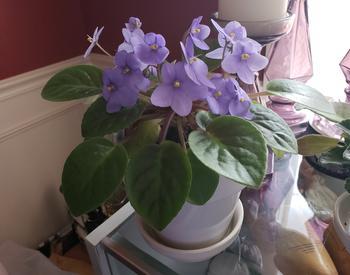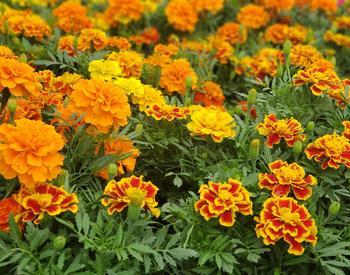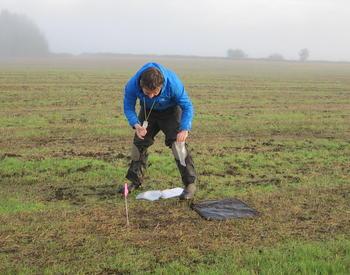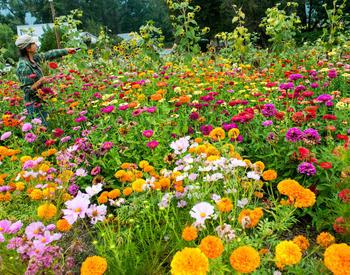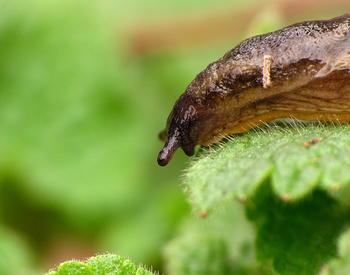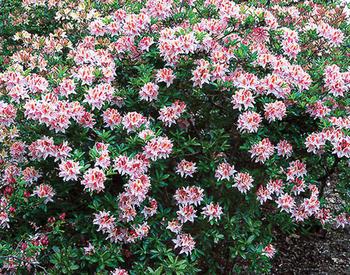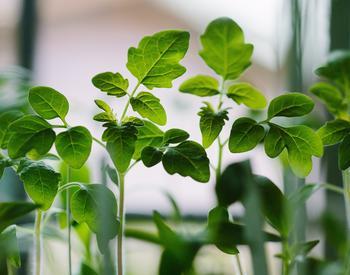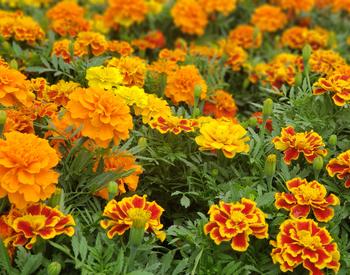Transcript
Speaker 1: From the Oregon State University Extension Service, this is Pollination, a podcast that tells the stories of researchers, land managers, and concerned citizens making bold strides to improve the health of pollinators.
I'm your host, Dr. Adoni Melopoulos, assistant professor in pollinator health in the Department of Horticulture. I get a lot of calls from people who want to create pollinator habitats in Oregon. And there are initiatives.
For example, in a previous episode with Cornpeace from the Xerces Society, we talked about the new conservation implementation strategy by NRCS in the mid-Columbia region. The issue is, however, it's hard to know whether pollinator restoration is helping pollinators. For example, it's not enough just to see if bees and butterflies are attracted to the flowers.
As you know from previous episodes with Jim Rivers, Sarah Galbraith, and Mia Park, it doesn't tell you whether those insects are having better reproductive outcomes and which specific pollinating insects are being helped. My guest this week has been a real pioneer on this issue. Lauren Panicio is an assistant professor in the Department of Entomology at UC Riverside. In this episode, we talk about this problem in some of her current research.
I'm also really delighted to have her on because this is the second guest we've had from the Center for Integrative Bee Research at the University of California Riverside. Remember, we had Hollis Woodard on a previous episode. And finally, this episode is going to touch on mason bees because Dr. Panicio has been using mason bees in her work. And incidentally, this episode was recorded at the Orchard Bee Association meeting, which was held in Riverside just last month. Anyways, without further ado, let's go check in with Dr. Lauren Panicio. All right, I'm in lovely Riverside in a gorgeous courtyard with Lauren Panicio from UC Riverside. Welcome to pollination.
Thank you. Now, we're here at the Orchard Bee Association meeting and it's the first time it's been held here in Riverside. And one thing that I've been quite amazed by is all the really great bee research that's happening here at Riverside. Tell us a little bit about the program here. Great.
Speaker 2: We have six bee researchers and five of us study native bees, one person studies honey bees. And we also have an incredible V-tex hummus all in the same university.
Speaker 1: And there's a tradition of this too. We heard the dean kind of address the association at the beginning going back to Timberlake. There's this really, tell us who he was and sort of this, what is this legacy?
Speaker 2: Yeah, he was hired as kind of a general insect tectonomus, but he really, really loved bees and he just would go out. I like to imagine him as this kind of a crazy tectonomus. We actually have his net in the museum, this tiny little net.
And he would just go out and catch like literally just hundreds of thousands of bee specimens from all over the Southwest and then identify them. And so we have this incredible record in our museum.
Speaker 1: Really, it's one of the world's repositories of bees. It's like a very snapshot of bees at that specific time. Yes.
Speaker 2: And we have Doug Enega, who is a California bee expert. And so he's actually the only person who can also read Timberlake's handwriting. Timberlake could write these tiny, tiny little labels. And so Doug is the only person, I think of him as this giant computer who can like, only he can parse the data of Timberlake's handwriting. So he's also actively trying to digitize the, or someone actively trying to digitize Timberlake's collection as well.
Speaker 1: Well, fantastic. Well, the other, when we think about, when I think about California, I think there has been some investment. There's been a lot of agricultural land development here, but there has been some investment to try and create some pollinator habits. We've had on previous episodes, Danielle Downey talking about the Seeds for Bees program.
We had, who's that person from Xerces here who does, kind of does a lot of the hedgerow work. Rachel Long? No, Jessica K... Anyways, listeners, I will put it in the show notes. Cruz, Jessica K Cruz. Oh yes, Jessica.
Yeah. And so there's a lot of activity down here. It seems like your work has really been interested in these features that can go into agricultural areas, specifically hedgerows. Tell us a little bit about hedgerows here in California. What do they look like? And what is a hedgerow? I guess we have to start with.
Speaker 2: The word hedgerow, kind of, is part of it. So it's like a row of shrub type plants along a field margin in our agricultural field. And so they used to be used in like grape britton stuff to delimit people's property. And so now we're going to bring them over here thinking this would be a great way to restore habitat without removing actual land for production.
Speaker 1: Right, because it's going to be on the headlands. It's not going to be in the productive area. And I know in Canada where I'm from, we used to have a soil, one of the hedgerows are really an erosion tool. It would really keep the soil in place by having a windbreak. It would slow the wind-down. But now, I guess there's this effort to make them into pollinator habitat.
Speaker 2: Yeah. So they've been planted in collaboration with the Zerchie Society to promote pollinators and back into these agricultural landscapes.
Speaker 1: And so there's a number of these around the state that you've been following for some time, right, into your PhD work.
Speaker 2: Yeah, I believe that Claire Kremmann, my PhD advisor, was really the one who started this work. And as a PhD student working in her lab, I was part of that. And we're continuing on that work currently looking at a different angle. But it was really Claire Kremmann who kind of came started this.
Speaker 1: Well, okay. So and they're a lot different. I think we've had past episodes where people have talked about meadows and putting perennials in or even cover crops. These are going to be features that are going to be in the landscape for some time.
Speaker 2: Yeah, they are shrubs. They're, you know, especially the mature ones that are over 10 years old. They're taller than us. And they're meant to be a permanent landscape feature. So they're not like a wildfire strip that you kind of have to constantly maintain. They're really meant to be, you know, imagine a head, like a literal hedge row, right? Just a row of tall hedges.
Speaker 1: Now, one thing that's often come up is that these are not large features. It's not like taking a CRP land, taking a whole bunch of land and restoring it. You're taking edges. And I guess the question is, you know, do these hedgerows have an effect on the communities?
Think about like this whole region has so many species and can these little features make a difference? How do we start thinking about that question? What are some of the challenges with being able to answer that question to begin with?
Speaker 2: Hmm. I mean, you can think of it in many different levels. One is just, do we get bees at these hedgerows? And the answer is pretty definitively yes. Like we get a high diversity and a high abundance of bees at the hedgerows.
Speaker 1: So they're attracted because there's these flowers so you can see them there. OK, why doesn't that seem like a great indicator? Is it is it not?
Speaker 2: Or I think that was a first step. Like they're using it. They're coming into the landscape. And then next we want to know, are they actually forming what we might think of as diverse communities across the landscape? And we did see that depending on where you were in space, there are actually distinct different types of bees in different areas. Like what we might expect in a natural landscape is not just that we're getting the same bee over and over and over again or a couple of bees in this landscape, which we do. If you just look at places without hedgerows, just regular weedy-filled margins. We tend to see the same types of species that can survive in that. Whereas the hedgerows seem to be supporting communities that are different through space.
Speaker 1: OK, so when you're looking at who comes, one of the ways that you can see that hedgerows are having some kind of an effect is that species that you would not see elsewhere in that landscape suddenly appear on the hedgerows. Yes. OK, all right. That's really neat, isn't it? That is very cool. Is that enough to answer that question or does that? Well, we kept on going. It's just taking us down the rabbit hole.
Speaker 2: So then we want to know, OK, where are they colonizing from? Like is it is a natural habitat nearby? Is it other hedgerows? And we found that they really behave like what we would call a metapopulation or a metacommunity, where depending on how many other hedgerows you have around you, you get higher rates of colonization, so like higher rates of new species coming in, which means that you're more likely to persist through the landscape. So it seems as though we put these like pieces of habitat, they're really just little pieces of habitat in this sea of agriculture, some of which supports bees, some of which does not. And then through time, we're building actual communities. Their new species are colonizing and they're persisting there. And they're also acting like we would think populations would where they're then sending off dispersers to like go find new habitat and establishing new populations.
Speaker 1: OK, so the idea would be something like this. You person plant a hedgerow and you I guess wait. And eventually, some bee that wasn't in that landscape before would find it and then maybe die or something.
Yeah. But eventually one of them is going to make a nest and it's going to have successful offspring and then it becomes a source of bees. But if that's the only hedgerow, then the chances that it will really kind of pick up again are poor. But if you have what you're finding is as you have more landscapes that really sort of populate up these hedgerows, then that that that bees starts to stick again in the landscape.
Speaker 2: Exactly. That's exactly right. So a couple of hedgerows, may not be that effective at supporting bee populations. But if we have lots of growers adopting these and putting them on their field margins, then they're basically little islands and acting like habitat for all these different bees.
Speaker 1: Fantastic. OK. Thanks for laying out the groundwork. Let's take a quick break. We're going to come back and I want you to tell us a little bit about your current research on this topic and also maybe some, you know, where, how this can, how we can get more of these in the landscape. Great.
OK, we're back now. So in this early research that you did, looking at these hedgerows, you're able to demonstrate there are these effects on these populations. We can start to see rare bees that just weren't in that landscape before came back. But I imagine that's not the end of the story. One, you know, there's more to it than a bee appearing. Tell us a little bit about your current research and how you're expanding on what you did.
Speaker 2: So we're really diving into what are the health of the populations. This is a collaboration with Hollis-Wodard and Quinn McFredrick, and we're funded by the Foundation for Food and Agricultural Research. And so we're going back out to the same hedgerows. We're catching bees like we usually did. But instead of just identifying them and moving on, we're freezing them. We're pulling out their guts. Oh.
It's fun. I'm very sad. But we're pulling out their guts, and we're seeing what types of parasites are inside of them. Oh. And then we're also looking at, we're using a species that we brought in, and we're looking at the health of the bees in terms of nutrition. So we're looking at how much fat they have, how much protein are they incorporating into their bodies. Okay.
Speaker 1: So let's unpack that in a second. And I imagine there's more to this than just that. But so the first thing is that they could be visiting these hedgerows, but they could be getting diseases, and they suddenly, it's not such a good thing.
Or I imagine all sorts of other things. But you're also looking, but one way to measure this is to look at the diseases. But also if they're doing well, they would be chubby.
Speaker 2: Yeah, exactly. Exactly. We're weighing them, seeing how much they weigh. Okay. Like how chubby they are. Okay. Sorry to throw you off there. Keep going. So going back to the, you know, you can imagine that you're in this landscape and you throw this beautiful floral resource into it, a hedgerow. And in the world of diseases, this could be a terrible thing, right? This could be a place where lots of sick bees might interact with flowers, which are basically the bathroom door handles.
Speaker 1: Oh yeah. And then more bees than visit those flowers, and they're picking up all these pathogens and parasites. And so they could be, or it could not matter, right? Like there's a lot of diversity of flowers. Some of them might transmit the pathogens, some of them might not. Same with the bees. And so in the end, it doesn't really matter for the bees. So really diving into, you know, you're a bee in this landscape are the hedgerows a source of bad things for you in terms of parasites and pathogens? And in a piece of that, you know, you can imagine like if you're just like, just like a, you know, human or a person, like if you're not doing very well, if you don't have a lot of like, you know, fats and proteins to be, you know, living on, you might be more susceptible to parasites and pathogens. So then we also want to look at, yeah, how chubby you are as a bee, and how much you weigh and like what do you, you know, what do you have in your body. And you mentioned that you brought a bee in. What did you mean by that?
Speaker 2: So one thing we, we struggle with a lot is, you know, we know very little about the really detailed life histories, a lot of these, a lot of these solitary bees in particular, a lot of them nest in the ground. And so we don't really know what their nests are doing. Like we can't really see them.
We can't see them. Yeah. We've just got a hole in the ground. Exactly.
And some people dig them up and, but there's a lot of work and then a lot of the growers are not going to be totally pleased with us like digging up there. Absolutely. So we brought in a, a, a, a, Azmiah, California, which is a native bee. Yeah.
Um, to, yeah, to California, to California as you can imagine. And this way we know exactly how all they are. You know, they start them out all the same time and we know exactly what they're doing. And then we can look at the reproductive rates and, and then they're, you know, they're fat storage and all those different pieces of what might make it like a nutritious, you know, living in a nutritious landscape and then having a healthy bee.
Speaker 1: Oh, it reminds me, we had an episode, we had a couple of episodes, one with Mia Park and one with Sarah Galbraith, where they also, they would put in some kind of mason bee and in Mia's situation, she was using alfalfa leaf cutting bee to sort of assess the health of an area. And so same, same idea, but they didn't use Azmiah, California. So this is a, a native mason bee. Is it, is it a mud? Does it use mud?
Speaker 2: Yes, it does use mud. And what's nice about it is it's an astro specialist and we're working in sunflower fields. So really, we are repairing our hedgerows with sunflower fields because we know it's a crop that bees use, like it's a mass flying crop that bees, these are visiting. And so these little guys are specialists on sunflowers. And so they're loving life in these sunflower fields and also visiting heteroplanets. Fantastic.
Speaker 1: Okay. So can you give us some preliminary results? Is, are these, do we know anything about whether the, these are, as you say, bathroom door handles or are they, are, and are the bees, you know, getting a lot of resources into their bodies so that they can be healthy?
Speaker 2: In terms of, we're still working on processing a lot of the specimens in terms of really being able to say, like, do hedgerows change your passage and loads and things like that? But what we can say so far is from the different types of species we've looked at, a variety of different native bee species, as well as honeybees. And there is a lot of them are sick and they overlap a lot in what, what parasites we are finding inside of them. And part of that is because like we don't, we know some of the parasites from honeybees and bumblebees.
And so we're really screening for very specific things. But yeah, osmia has parasites we see in bumblebees inside of it. So do the honeybees. So it's unclear, like where it comes from. Maybe it comes from the honeybees and moves the native bees. Maybe it starts in the native bees and moves to the honeybees. But there are a lot of bees out there with that. Okay.
Speaker 1: So there's that part of it. But the other thing I remember you mentioning is that maybe you could offset that if they did, they were healthy. And so are we seeing where hedgerows are, are these bees?
Speaker 2: I don't think we're quite, we don't quite have enough data to be able to answer that yet. So we're still processing our kind of second year of data. And we'll, we'll, we'll know soon. But right now it's just looking like there's just lots of sick bees out there.
Speaker 1: Well, fantastic. That's not, that's not fantastic. Fantastic that you're ongoing. And I think this sounds like, this sounds like a really great way to get at things. Because I think one of the things that we commonly think of is, is we need to plant more flowers.
It really has been drilled into us. And we, thinking about the contacts, thinking about the bee community, thinking about the pathogen community, that this may be a more complex issue in science that's sort of directed at these questions can allow us to make better conservation decisions.
Speaker 2: Or potentially, you know, maybe in this landscape, as you mentioned, they are really small restorations on these farms. And if we had more of them, they wouldn't be such concentrators.
Speaker 1: So understanding more about configuration of these hedgerows and think really thinking about these as meta populations and populations and how we can restore them.
Speaker 2: You know, moving, moving past, like this is an agricultural landscape, which is really different than nature. And like, okay, we're, we're actually building an artificial landscape with these different pieces of habitat. Let's apply all the things we know from nature to restore these different areas. So.
Speaker 1: Great. Well, I said the last we have a segment that I subject all my guests to is a bunch of questions. If you're okay, we'll take a quick break and we'll come back and. Great. Let's see what your answers are. OK, awesome. OK, we're back. So three questions I asked all my guests. First one is, do you have a book recommendation?
Speaker 2: I do. It is Bees of California Art, Science and Poetry. And it is a compilation by Haman Tall Cohen. And it is she did it as a graduate student. It's got all these incredible B.R. and poems and it was done by UC Santa Cruz undergrads and lots of contributors.
Speaker 1: OK, so she is this is a compilation and but she's also a graduate student in your lab who's doing some of the work that you described.
Speaker 2: Yes, she's actually a postdoc now.
Speaker 1: Oh, she's a postdoc. She did this as a grad student. OK, all right. So and so tell us a little bit about the book. What's it what's it like?
Speaker 2: Oh, it is just a beautiful book. Every page is like another amazing piece of art. And then on the other side of it, there's like a fun haiku about bees or like a lot of them. And so it's just a lovely thing to have on your copy table and really enjoy when you're thinking of bees and wanting to kind of, you know.
Speaker 1: No, no, that's really great because we don't know that on them. Oftentimes, you know, I think on the show, people are either, you know, doing some restoration. We have people who are kind of really passionate about learning about bee biology, but there is this whole other dimension that's, you know, right through the ages where people have, you know, used bees for inspiration for art or or poetry. And I think that's and I think we may not have another example of that on 120 so orish episodes.
Speaker 2: Yeah. And there's a whole, I mean, it's, it's, it really gets you a feeling of just not only, you know, the amazing different species out there, but artists interpretation of their lives and their life history. So fantastic.
Speaker 1: We will put a link to it on the show notes as people can look it up. Our next question for you is, do you have a go to tool? Yeah.
Speaker 2: So when we were doing a lot of these studies, we always want to keep, we want to know what the flowers, the bees were visiting. And so we wanted to find a way to keep each basically be separate
Speaker 1: to its flower host, to his flower, because you have one contained, you would have to have a container per flower. How do you do that?
Speaker 2: So we have, we've made these kill jar bandoliers is what we call them. They look like ammo straps.
Speaker 1: Oh, like, like Chewbacca would have in Star Wars.
Speaker 2: Chewbacca. Exactly. That was the time I was thinking of. But instead of ammo, they have little tubes for us to put our bees in.
Speaker 1: Oh, so that which is really convenient because I usually use something like a fishing vest, but everything is jumbled around in that pocket. It's hard to get the one that I want.
Speaker 2: You need to kill jar bandolier.
Speaker 1: So is there a kill jar bandolier on Amazon?
Speaker 2: You just get some nylon straps and some elastic and someone who knows how to use sewing machine.
Speaker 1: OK, great. And so you'd have a little slot and then that way I see how handy that could be because, you know, you just know muscle memory that, you know, the roses are in position three, really easy to access them.
Speaker 2: We've got some adorable pictures of us in them. Maybe I'll send them to you.
Speaker 1: Actually, that would be also in the show notes guests. Hold you to that. A great tool, great tool. OK, so our last question is always a difficult question, but is there a pollinator species that you let foot spy? You're kind of like, I really love that little critter.
Speaker 2: This is tough because I think I love all all native bees. And I think one thing we don't think a lot about is all the male bees out there. Oh, yeah. And the two male bees that I think are the absolute cutest are male melisodes, which sleep in some flowers. And so whenever we are out there in the morning, they'll all be like piled up in little clumps in the sunflower ads. And since they're males, they don't sting. And so you can just like pick them up and kind of like snuggle them a little bit.
Speaker 1: And there's such a furry bee.
Speaker 2: You're still very little teddy bears. So there's probably that's a big one. The other one are male mega Kylie. Yeah, they have the little mittens like
Speaker 1: they have these adorable little fluffy mittens. Yeah, yeah. And I will right on the front legs and they're just like they really look like mittens.
Speaker 2: They really look like this. And I don't know if you've ever had little bees licking you when it's like they're like need some salt or something like that. I've always found the male mega Kylie like tickle because of their own mittens.
Speaker 1: That those are such great. Just like watch them. Well, those are such great choices. And I think like and summer summer bees from California.
Speaker 2: Summer bees, you're right. Yeah, but some of these.
Speaker 1: But I do we have I see melisodes, males like I've seen them in flowers, but I've also seen them on like a stem or something. And then you walk by them and you're like, huh, there's something funny about that plant and then you look closely and it's just like there's lots of them. There's like 20 males. Yeah. Which I imagine I don't quite understand what the biology of that, if it's for protection or protection could be warms.
Speaker 2: Yeah. But yeah, you can just walk right up and nab one.
Speaker 1: Yeah. I admittedly in Oregon, we do because they're so easy to tell the males and females apart. There are great if we're doing a tabling event, we'll often go around to the composites and get a few in jars. And then people can pet them very easily. So they're just a great bee that way.
Well, it sounds like the Mason B Association meeting has broken for coffee. So thanks. And with that, thank you so much for joining us on the show. Thank you.
Thank you so much for listening. The show is produced by Quinn Sinanil, who's a student here at OSU in the New Media Communications Program. And the show wouldn't even be possible without the support of the Oregon Legislature, the Foundation for Food and Agricultural Research in Western Sarah. Show notes with links mentioned on each episode are available on the website, which is at pollinationpodcast.oregonstate.edu
I also love hearing from you and there's several ways to connect with me. The first one is you can visit the website and leave an episode specific comment. You can suggest a future guest or topic or ask a question that could be featured in a future episode. But you can do the same things on Twitter, Instagram or Facebook by visiting the Oregon Bee Project. Thanks so much for listening and see you next week.
Hedgerows can be great ways to attract pollinators in agriculture and forestry settings. But how can such relatively small plantings impact pollinator abundance and diversity on larger scales? This week we dig deep into the science of how hedgerows contribute to pollinator health.
Lauren Ponisio is an Assistant Professor in the Department of Entomology at the University Of Riverside and part of the Center for Integrative Bee Research (CIBER). Her lab focuses on understanding the mechanisms by which species interactions maintain species diversity, and how this information can harness these processes to manage and restore diversity in human-modified systems. The Ponisio Lab’s aim is to discover new insights into how communities form, evolve, and persist through time and space, aiding in the prediction and prevention of community collapse.
You can Subscribe and Listen to PolliNation on Apple Podcasts.
And be sure to leave us a Rating and Review!
Links:
Dr. Ponisio’s Book Recommendation: Bees of California: Art, Science, and Poetry
Dr. Ponisio’s Tool Recommendation: Killing jar bandolier
Dr. Ponisio’s Favorite Pollinator: Male sunflower bees (Melissodes), Megachile

